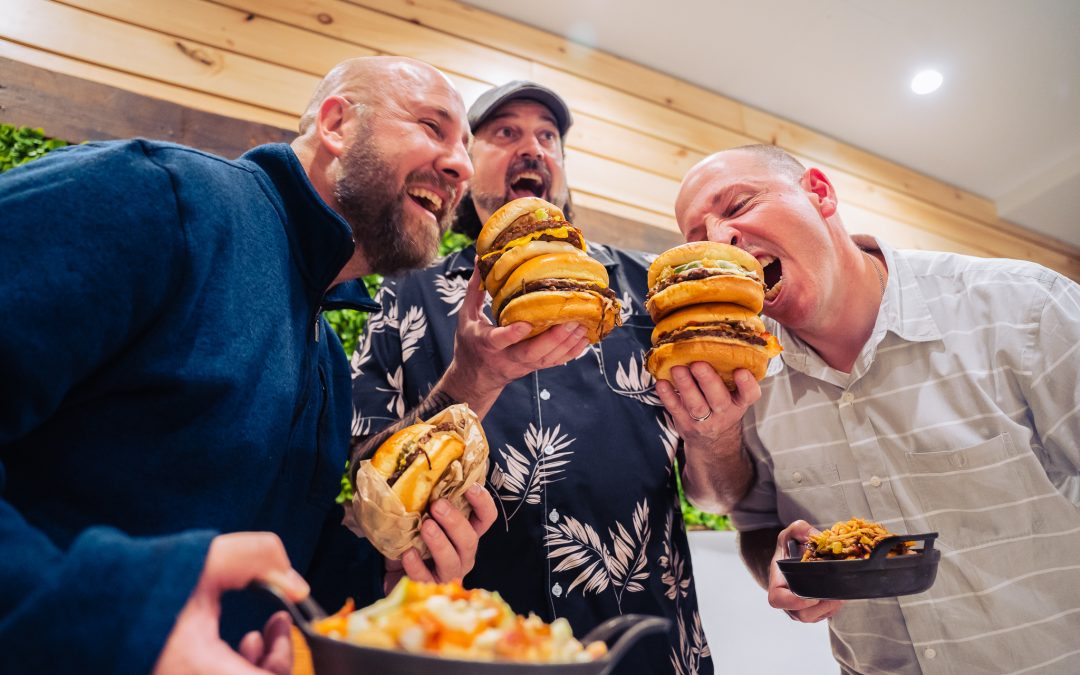New York City-based Handcraft Burgers & Brew is the next Food On Demand Outstanding Operator.
As one of three co-owners of a two-year-old quick-serve burger joint east of Times Square, David “Rev” Ciancio appears to be living a tailor-made dream of putting his marketing chops to the test in one of the most intense, busy trade areas in the United States.
Ciancio is one of the most widely known thought leaders in the restaurant industry, a well earned position after his years spent as a software and marketing expert at his Yeah! Management consultancy and a fixture at industry conferences. Aside from helping run this 14-seat restaurant, he’s also the head of revenue marketing at Branded Strategic Hospitality and a board advisor on Lunchbox’s Food Tech Council.
With a full plate, it’s clearly the burger business that’s captured his heart.

David “Rev” Ciancio is one of three co-owners of New York’s Handcraft Burgers & Brew.
“We just put pictures of burgers on the internet, man, that’s it. That’s the secret,” he said while explaining the philosophy behind a marketing program revolving around goofy antics, amusing menu hacks and constantly saying “thank you” instead of asking for anything beyond an email address from the brand’s repeat customers.
The storefront off of 40th Street is kitty-corner to Bryant Park, and was formerly a falafel restaurant before the owner “just walked away” from the location during the pandemic. After the landlord approached Handcraft’s other two co-owners, Chad Gaudet and Chris Delmond, they decided to build out a burger restaurant along the street frontage and use the back two-thirds as as commissary for Handcraft, as well as their other restaurants on the same block.
While that physical setup is innovative on its own, and delivered a $1.3-million average unit volume in just its second year in business, it’s the less obvious qualities that make Handcraft Burgers & Brew so noteworthy among its peers.
A data and experience play
“We don’t have any cash registers, and that’s on purpose,” Ciancio said. “I want to capture everyone’s email address, so I want them to order via their mobile phone or the kiosk—it’s really a data capture play, but it’s also an experience play.”
 Rather than having employees behind the county, like most QSRs, Handcraft has somebody acting as a maître d’ greeting guests and helping them get started with their orders on their phones through a QR code or on a kiosk.
Rather than having employees behind the county, like most QSRs, Handcraft has somebody acting as a maître d’ greeting guests and helping them get started with their orders on their phones through a QR code or on a kiosk.
They do have one Toast cashier’s kiosk, because it’s illegal to be cashless in New York City, but it’s only used for the rare guest who doesn’t want to order themselves.
“Essentially, it’s a full-service experience, but a quick-serve restaurant,” Ciancio added, noting that dine-in guests aren’t given a number. Instead, the host remembers names and brings the food out as soon as it’s ready.
Self-serve drinks help further reduce the need for staffing, and the free wi-fi only requires an email address to get started—a small step for guests, but a critical feature of the brand’s database building. At its absolute busiest, the whole restaurant can run on just four employees.
The owners based their asset-light business model on Crumbl Cookies, which deploys a similarly modern, lean model that uses guest-facing technology to minimize staffing and interact with customers in creative ways.
For 2024, the brand is gearing up to use new Bite kiosks that capture more customer data, offer smart upsells to customers and can use facial recognition to take even more friction out of the guest-led ordering process.
Noting that delivery performance has gone downhill in the big city, claiming that third-party fulfillment providers are batching more orders than ever, Handcraft temporarily turned off delivery a few weeks ago—which was do-able as it only comprised 15 percent of its overall volume.
While the brand also gets a “ton” of customer pickup orders, the restaurant had $500 worth of returned orders a few weeks back through one delivery provider in a single day. Because of that degraded performance, the brand is implementing new packaging to better optimize for the longer delivery times that Ciancio said have become increasingly common.
To boost to-go orders, email blasts and other communications highlight the ability to grab a burger before heading over to Bryant Park to check out the winter village that has ice skating, see-through igloos, bumper cars on ice and holiday shops.
A thank-you machine

A former falafel restaurant made for an easily convertible storefront.
Handcraft’s team is always prioritizing the guest journey and a better dining experience, which is part of the reason they push order-ahead in its customer-facing messages. A skip-the-lines email that recently went out ended with “thank you!” in capital, bold letters—which is part of every single message sent out to its list.
 “We don’t really think of ourselves as a burger shop, we think of ourselves as a thank-you machine,” Ciancio said. “If you go look at our social media, every single post ends with ‘thank you.’ If you’re on our email list, every single email ends with ‘thank you.’ If you go look at some of the stuff on our website, it says ‘thank you’ all over the place.”
“We don’t really think of ourselves as a burger shop, we think of ourselves as a thank-you machine,” Ciancio said. “If you go look at our social media, every single post ends with ‘thank you.’ If you’re on our email list, every single email ends with ‘thank you.’ If you go look at some of the stuff on our website, it says ‘thank you’ all over the place.”
That process officially begins when receiving a new customer’s email address for the first time, which kicks off a nine-email campaign that plays out through automations over the next several weeks.
It begins the next day with an email from the owners, and then delves into why they started the restaurant. From there, there are eight more emails sent every six days, explaining the brand’s position on gratitude, the charities it works with, as well as details like highlighting their chicken sandwich or how the loyalty program works—all ending with thanks.
After a customer has visited the restaurant a fifth time, they get a special email welcoming them to the five-timers club, a hometown Saturday Night Live reference.
The next step on the guest journey involves asking for a guest’s birthday as part of a two-question survey through the Ovation platform, which then fakes the customer out by saying “we don’t do birthday gifts here, we do half-birthdays”—adding that six months from your birthday you’ll get a free burger.
Asked where the brand sees its currently shelved delivery operation years from now, CIancio said “we don’t pooh-pooh off-premises, we love it, but we just know the burger is better when you eat it right in front of us.”
Expecting the third-party delivery experience to further degrade in the big city, Handcraft would rather control more of the guest experience rather than relying so heavily on outsourced delivery fulfillment.
Handcraft’s Instagram page leans heavily on impressive food photography, but also on Ciancio who is the brand’s uncommonly outgoing figurehead.
Like other aspects of the business, the messaging all comes back to capturing email addresses. In the rare instance somebody offers negative feedback through its guest feedback channel, Ciancio reaches out and gives them 100 loyalty points to incentivize them to come back again, rather than writing off the store for good.
“Eating burgers is supposed to be fun,” he added. “You know, we act like a local burger shop, but we think like McDonald’s.”
The Outstanding Operators Program is highlighting 20 innovative brands taking creative paths to success with all things off-premises. Winners receive a $1000 charitable donation to the organization of choice and will be recognized on-stage at the 2024 Food On Demand Conference. Register today!
The Outstanding Operator program is sponsored by industry leading partners
 |
 |
 |


